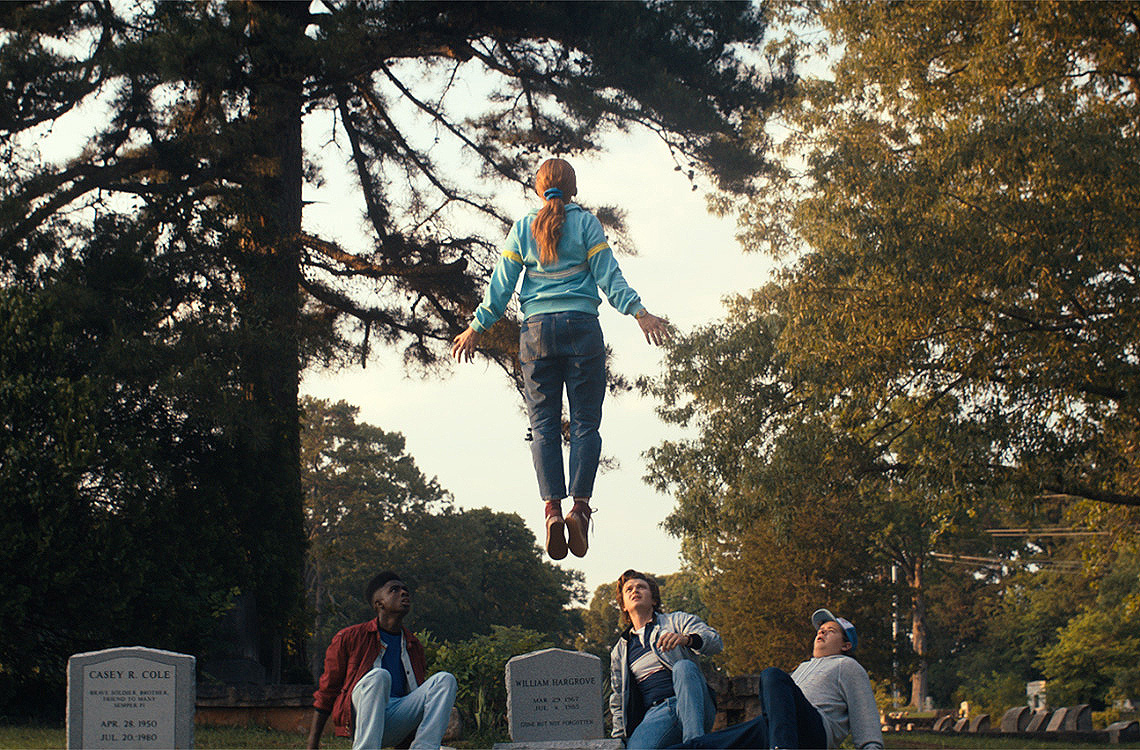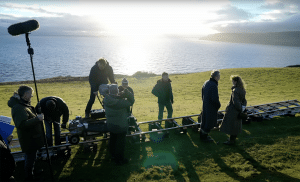A good soundtrack creates a memorable narrative. The trick is using music to tell the stories the camera can’t.
No matter the project, a soundtrack is more than just a few catchy tunes that keep the beat. A proper soundtrack picks up critical storytelling elements and weaves them into the experience, without wasting a bunch of time on exposition and backgrounding. A really good soundtrack does this while also worming its way into your brain and sticking there. When the soundtrack really lands, the entire project does too, and isn’t that every content creator’s true goal? To create something people remember . . .
So, whether you’re selling real estate, advertising cars, or making movies, don’t underestimate the power of your soundtrack. Think like a director, and let music make the mood.
But don’t take our word for it. Here are some soundtracks in action that are more than the sum of their parts.
Sonic Foreshadowing
We’ve all rediscovered our love for Kate Bush with the use of her classic hit “Running Up That Hill” in Stranger Things season 4. Over the course of the season, the song becomes a critical part of Max’s character. The song first crops up in episode one as a bit of audio foreshadowing. Nostalgia is a powerful tool when it comes to connecting audiences with characters. Early scenes pair the song with memories of walking home from late-night D&D games with Hounds of Love cranked in the crappy, orange-foam-covered headphones of a vintage Walkman.

The combination is a powerful hook, and it sets the tone for audio character-building that doesn’t let up throughout the season.
Enter the Melody
A melody (or, in Max’s case, an entire song) attached to a character is a leitmotif, and it comes from French and Italian opera in the late nineteenth century. It developed as a form of aural shorthand to inform the audience which characters were on-stage without a lot of exposition that would grind the narrative to a halt.
Richard Wagner, in his four-opera cycle Der Ring Des Nibelungen, used hundreds of leitmotifs to identify and track characters, thematic threads, and reoccurring aspects of his narrative flow. You can’t blame him, really. Der Ring Des Nibelungen is usually performed over the course of a week, running more than fifteen hours, with a cast of more than thirty speaking roles. And we’re not talking roles like “Valkyrie #4” or “Smallish Giant Who Carries the Bucket of Spears.”
Pull out a copy of John Williams’s score for The Empire Strikes Back, and you’ll notice that the “The Imperial March” is subtitled as “Darth Vader’s Theme.” Watch the film again, and notice how often that melody comes marching in. We all know the song, and it conjures an instant reaction . . .
Thirty-six years later, when Michael Giacchino was arranging the music for Rogue One, he probably got one note from director Gareth Edwards about the soundtrack. At the end of the movie, when the rebels are out of time, and they’re all lining up to face their doom, and that red light cuts through the darkness in the hallway, all the audience needs is to recognize Darth Vader, and the scene takes on a deadly ominous chill — with nary a word — all thanks to the brass section.
And this reveal is collaborative. The audience has heard this melody over and over again. We know what it signifies. We know what we’re supposed to feel when we hear it. The director has primed us to be more engaged with the narrative at this point and in this manner. Is it manipulative? Sure. But that’s what makes scenes like this memorable. That’s what makes them stick.
Sticking the Landing
A director can also use a song we know as punctuation, to really stick the emotional impact of a scene. Director Tony Scott was known for being clever with his use of audio cues and sonic embellishments. Take 2004’s Man on Fire, for instance. Denzel Washington plays John Creasy, a washed up ex-Force Recon officer, who accepts a bodyguard job in Mexico City from an old friend. The person he’s protecting is Lupita Ramos, played with all the wide-eyed precociousness in the world by Dakota Fanning. Naturally, things go terribly wrong.

Early in the film, Scott has introduced a leitmotif for Creasy. It’s nothing much — just some discordant guitar notes. It’s kind of like what you hear at the beginning of a Lil Nas X song. It shows up now and again as Creasy works through his own emotional baggage. But, if you recognize the motif, you know it’s from “The Mark Has Been Made,” an instrumental Nine Inch Nails song from the album The Fragile. It’s a lovely little song that suggests a storm clouds on the horizon sort of mood. Until it breaks, and then it’s Industrial Skronk for days.

So, here we are: Lupita has been kidnapped. Creasy’s in her bedroom, holding her teddy bear. Lupita’s mom comes in. They get emotional over the teddy bear. She says, “What are you going to do?”
Cue the discordant guitar notes.
Creasy: “I’m going to kill them all.”
Cue the Industrial Skronk crescendo and the Man on Fire montage.
This is how you own your audience.
Aural Wallpaper
Brian Eno once likened music to “aural wallpaper” — a good soundtrack freshens up the room without being obtrusive. You wouldn’t ordinarily think of Nine Inch Nails as wallpaper, but David Fincher discovered that Trent Reznor and Atticus Ross (the duo behind Nine Inch Nails) take direction very well.
Fincher asked the pair to provide a very wallpaper-y soundtrack to The Social Network, his film about the formation of Facebook.

Reznor and Ross created the aural textures that Fincher wanted, and they won the Oscar that year for Best Soundtrack. Why? You just have to watch the first ten minutes of the film to see why.
The film begins with five minutes of Jesse Eisenberg and Rooney Mara flinging dialogue at each another, but once Zuckerberg (Eisenberg) leaves Albright (Mara) and heads across campus, the late-night walk acquires the delicate atmosphere and plaintive piano of “Hand Covers Bruise.” Zuckerberg gets to his dorm room and starts coding what will become Facebook, and that frenetic night of creation carries the electronic beats and synth swirls of “In Motion.” It creates a one-of-a-kind cinematic mood — one memorable enough to earn filmmaking’s top nod.
Music and audio cues are incredibly useful tools for directors. They help frame and focus a scene, and they establish characters and themes. Soundtracks can even tell stories that the camera can’t, sparing audiences boring sequences of exposition and hand-holding. Music tells an audience how they’re supposed to feel.
We elevate our lives with personal playlists and soundtracks; we should do the same with our movies.
Cover image via Netflix.
Looking for more on music and audio? Check out these articles.



